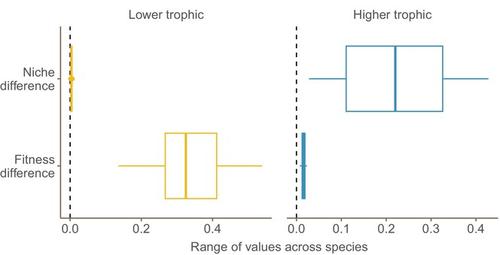当前位置:
X-MOL 学术
›
Ecol. Lett.
›
论文详情
Our official English website, www.x-mol.net, welcomes your feedback! (Note: you will need to create a separate account there.)
Trophic tug‐of‐war: Coexistence mechanisms within and across trophic levels
Ecology Letters ( IF 7.6 ) Pub Date : 2024-04-09 , DOI: 10.1111/ele.14409 Chuliang Song 1, 2 , Jurg W. Spaak 3, 4
Ecology Letters ( IF 7.6 ) Pub Date : 2024-04-09 , DOI: 10.1111/ele.14409 Chuliang Song 1, 2 , Jurg W. Spaak 3, 4
Affiliation

|
Ecological communities encompass rich diversity across multiple trophic levels. While modern coexistence theory has been widely applied to understand community assembly, its traditional formalism only allows assembly within a single trophic level. Here, using an expanded definition of niche and fitness differences applicable to multitrophic communities, we study how diversity within and across trophic levels affects species coexistence. If each trophic level is analysed separately, both lower‐ and higher trophic levels are governed by the same coexistence mechanisms. In contrast, if the multitrophic community is analysed as a whole, different trophic levels are governed by different coexistence mechanisms: coexistence at lower trophic levels is predominantly limited by fitness differences, whereas coexistence at higher trophic levels is predominantly limited by niche differences. This dichotomy in coexistence mechanisms is supported by theoretical derivations, simulations of phenomenological and trait‐based models, and a case study of a primeval forest ecosystem. Our work provides a general and testable prediction of coexistence mechanism operating in multitrophic communities.
中文翻译:

营养拉锯战:营养级别内和跨营养级别的共存机制
生态群落涵盖多个营养级别的丰富多样性。虽然现代共存理论已广泛应用于理解群落组装,但其传统形式主义仅允许在单个营养级内进行组装。在这里,我们使用适用于多营养群落的生态位和适应度差异的扩展定义,研究营养级别内和营养级别之间的多样性如何影响物种共存。如果单独分析每个营养级,则较低和较高营养级都受相同的共存机制控制。相反,如果将多营养群落作为一个整体进行分析,则不同营养级的共存机制受到不同的共存机制的控制:较低营养级的共存主要受到适应度差异的限制,而较高营养级的共存主要受到生态位差异的限制。这种共存机制的二分法得到了理论推导、现象学和特征模型的模拟以及原始森林生态系统的案例研究的支持。我们的工作为多营养群落中的共存机制提供了普遍且可测试的预测。
更新日期:2024-04-09
中文翻译:

营养拉锯战:营养级别内和跨营养级别的共存机制
生态群落涵盖多个营养级别的丰富多样性。虽然现代共存理论已广泛应用于理解群落组装,但其传统形式主义仅允许在单个营养级内进行组装。在这里,我们使用适用于多营养群落的生态位和适应度差异的扩展定义,研究营养级别内和营养级别之间的多样性如何影响物种共存。如果单独分析每个营养级,则较低和较高营养级都受相同的共存机制控制。相反,如果将多营养群落作为一个整体进行分析,则不同营养级的共存机制受到不同的共存机制的控制:较低营养级的共存主要受到适应度差异的限制,而较高营养级的共存主要受到生态位差异的限制。这种共存机制的二分法得到了理论推导、现象学和特征模型的模拟以及原始森林生态系统的案例研究的支持。我们的工作为多营养群落中的共存机制提供了普遍且可测试的预测。











































 京公网安备 11010802027423号
京公网安备 11010802027423号